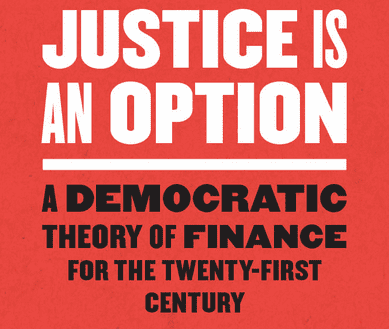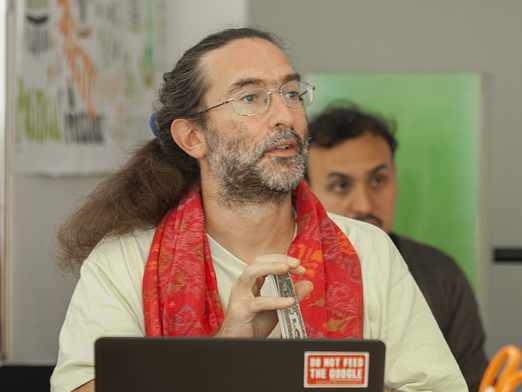
I've been immersed in monetary theory for several years. At one point I realised that money-as-we-know-it and markets are actually just two aspects of the same idea, and that the two evolve together. So saying, I've read a lot about money, its sociology, history, philosophy etc, but very little about markets.
This book is about modern financial markets more than money, but it does talk about monetary creation events such as quantitative easing, and the markets' need for various quantities of money. The title of the book is a pun, because the book is really about traded options, financial instruments that allow you to buy or sell assets at a known price in the future. Options provide a sort of insurance against the vicissitudes of the markets and can make doing business a bit more predictable.
The fundamental price of an option has 2 components:
- the difference between the current price of the asset it is based on, and the price at which the option is set
- the chance that the real price will change a lot before the option expires, which is based on the volatility of the price. This is the interesting one because the price of the option fluctuates as a square of the volatility of the underlying asset, which means
I've written at length about why and how the economy is impelled to grow, and Meister added to my knowledge. Rich people mostly don't hold money, they hold assets like shares because they intend to get richer when those prices go up (compared to money). The rich people measure their wealth using money, which means if they sold all their assets at the current price they would be $Xm rich.
Now, despite the best efforts of the leading neolib-tard economists, markets seem to crash with increasing force and perhaps frequency. One reason for this is that more your assets are worth, the more money you can borrow to buy more assets, but the more vulnerable you are to price drops.
Then one day all the rich people decide, as if by an invisible hand, that they don't want to hold assets any more, assets are falling, they want to hold money instead, which is safe. And everyone wants to sell. This creates 2 difficulties
- everyone can't all sell all their assets all at the same time, especially not at the current price, because for every seller their must be a buyer.
- there isn't enough actual money in the world, which if you think about it, is another way of saying the same thing. Money is after all supposed to be a medium of exchange, not a government-guaranteed backstop for financial speculators.
The government too, captured by the self-anointed too-big-to-fail institutions, can't allow the prices of all these assets to fail. This is the weak point of the whole system. I would have liked Meister to say a bit more about why. But the upshot is that it does a bailout and in order to keep the markets functioning, basically buys a load of these assets which the rich people have bid up and then decided the price was too high. Pretty big favour no? And of course Big Finance already knew they are going to do that, and adjusts its risk levels (upwards) accordingly.
Meister's point is that since the government is in fact insuring private actors against market crashes, why isn't it collecting an insurance premium, which would at least cover the costs; and the obvious mechanism for that insurance premium would be the options market.
Since the government isn't doing that, and isn't likely to do it while those actors are financing their election campaigns, what then shall we do? Meister devotes a chapter to explaining how one of the biggest risks to markets is revolution, and uppity plebs, even unsuccessful ones make the markets wobble. A bit crash like 2008 is a moment of maximum risk that the government might not bail out and the markets might actually fail and the balance of power might change. That means, using options, the more disruption the plebs can cause, the more money they can make. They might even use the money to cause even more disruption. This wouldn't even be an original strategy, plenty of hedge funds make money out of market volatility. It's not as they are more worthy citizens than disgruntled plebs. The main difference is that the plebs could be accused of insider trading if they create the volatility off which they profit.
But the book isn't only about how to extract money by disrupting business as usual. A large part of the book is given over to why this is actually a legitimate form of restitution, and why it is morally justifiable to make rich people pay for NOT making a revolution. Meister's argument is about justice, but specifically historical justice. The financial system compounds the theft and extortion of the past by constantly increasing the gap between the enriched perpetrators and the impoverished victims. There's a lot of interesting and scholarly discussion around the current beneficiaries and victims of past injustice and the reasons for, and type and degree of restitution. Meister says that justice is very literally an option in the financial sense, And if you have that option you can you can cash it in now, or roll over in hope of the price increasing as justice (in the form of a political revolution) comes, or seems, closer.
After reading the book I'm left with a feeling I've had before, that there is something broken in our current financial system; not the immorality, the shit economics, the corruption, but something fundamentally unworkable; as if the crashes and the bailouts which seem to catch everybody by surprise, are actually an inherent part of the system dynamics, but they are framed as accidents and emergencies so that they can say the system works most of the time. At the core of this idea is the notion of liquidity, which is very much explored in The End of Finance (audiobook). Liquidity is like the steel girders of the intellectual edifice of capitalism except when the earth quakes, they turn to jelly.
Here are some highlights if you are still hesitant to dive in.
I was excited to learn that there is a nascent startup which intends to take these very theoretical ideas and put them into practice.
This book is very academic and I found it hard work, so I hope this review was a helpful distillation. Running time: 11hrs 30 mins. Buy the book!

Comments